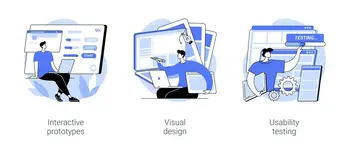
Table of contents
Studies show that students learn better and have more fun when they are involved in their learning. Interactive learning environments, whether in a classroom or online, can help students learn more effectively and have a better educational experience.
Interactive content can help students feel more confident and motivated. When students do hands-on activities, they learn by doing and feel more confident in their abilities. Educators and organizations should create learning experiences that are engaging and help students easily remember what they learn.
To make the power of interactivity work, you need to include things like different scenarios, group discussions, and problem-solving exercises in your learning activities. This will create a dynamic and engaging learning environment that meets the needs of all learners.
The Power of Interactivity
1. Increasing Engagement
Interactivity makes learning more fun and interesting. When learners can interact with the content, they are more likely to pay attention and remember what they learn. Interactive content can include quizzes, polls, and interactive multimedia resources. This type of content can help learners learn at their own pace and make sure they understand the material.
A
study
found that interactivity can triple learning retention rates. This means that learners who interact with the content are more likely to remember what they learn for a longer period of time. This is because interactivity helps learners to actively engage with the material, which makes it easier for them to understand and remember.
Interactivity can also improve the overall learning experience. When learners are engaged with the content, they are more likely to enjoy the learning process. This can lead to better learning outcomes, as learners are more likely to be motivated to continue learning.
2. Enhancing Learning
When students participate in learning, they are more likely to remember what they learn. One way to make learning more engaging is to include interactive activities that require students to think critically and learn in a meaningful way. Research has shown that interactive learning helps activate long-term memory and alertness, which are important parts of learning. By creating interactive eLearning courses, educators and organizations can help students learn more effectively.
3. Building Stronger Connections

Interactivity is not just for the classroom or online learning. It can also help people connect with each other at events, meetings, and conferences. Interactive events let people talk to each other, share ideas, and discuss things. Some examples of interactive activities are live polls, Q&A sessions, and breakout groups. By using interactivity, organizations and communities can make their events more fun and memorable.
Why You Need Interactivity
Interactivity is important for businesses because it can help them grow, keep customers, and reach new people. In this section, we will talk about why interactivity is important and how you can use it to benefit your business.
1. Boost Your Business Growth
Adding interactive features to your customer-facing platforms can help you grow your business. Interactive experiences can attract new customers and make them happy, which leads to them coming back and telling their friends about you. Studies have shown that interactivity can help people remember things better and have more fun using your products or services.
2. Improve Customer Retention
Interactivity is important for keeping customers loyal. When customers can interact with a company, they feel more involved and valued. This can lead to them staying with the company longer.
Interactive elements can be used in customer service, marketing campaigns, and other forms of communication. For example, a company could have a live chat feature on its website so that customers can ask questions in real-time. This would make customers feel like they are being heard and that their concerns are important.
Active involvement in the customer journey is important. This means that customers should be able to participate in the process of buying a product or service. For example,
Nike By You
is a service provided by Nike allowing customers to personalize and design their own Nike merchandise.
Interactivity is also important for adult learners.
When adult learners can interact with the material they are learning, they are more likely to stay engaged and retain the information
. This is because they are able to actively participate in the learning process.
3. Attract New Audiences

When businesses interact with customers in new ways, they can be more innovative and attract new customers. Interactivity is important in digital media and communication because it
helps businesses build stronger relationships with customers
. Businesses can offer unique and personalized experiences that go beyond just selling products or services. This can help them attract new customers from different groups and make their brand stand out from the competition.
Using interactivity in businesses can help them grow and keep customers coming back. It can also help businesses reach new customers, no matter their age or background. Interactive experiences that appeal to a wide range of people can help businesses be more successful.
How to Get Interactivity
(a) Implement Interactive Elements
To make your content more interesting and engaging, you can add interactive elements that allow your audience to participate. One way to do this is by using branching scenarios in interactive videos, which let learners explore different outcomes based on their choices. This can help them think critically and improve their learning experience. Another way is to include quizzes, polls, or games that encourage learners to apply their knowledge and actively participate. And don’t forget to make your content visually appealing by using multimedia elements like images, videos, and animations.
(b) Utilize Social Media

Social media is a great way to get people involved. You can do this by creating and sharing interesting content that people will want to like, comment on, share, and discuss. You should also post a variety of content, such as articles, images, videos, and polls. This will keep people interested and engaged. Additionally, you can use social media to communicate directly with your audience by responding to their comments, questions, and feedback. This will help to build a sense of community and collaboration.
(c) Organize Interactive Events
Events that let people do things and work together are good ways to get people involved and interested. Workshops, online classes, meetings, and other events can give people hands-on experiences and chances to work with others. When planning these events, make sure the plans include ways for people to talk to each other and share ideas. Have group discussions, brainstorming sessions, and problem-solving activities to make the events fun and interesting. And don’t forget to have time for people to meet each other and make friends.
Measuring the Results of Interactivity
Key Performance Indicators
To see how well interactive learning activities are working, we need to look at key performance indicators (KPIs). These are numbers that show how well something is working. Common KPIs for interactivity include:
-
Completion Rates: Find out how many learners finish the interactive sessions.
-
Engagement: See how much time learners spend on the content and how involved they are.
-
Assessments: Check learners’ understanding and how well they remember what they learned through quizzes or tests.
Analyzing Feedback
Another important part of measuring how interactive something is is to get feedback from the people using it. You can ask for feedback in a few different ways:
-
Surveys: You can send out surveys to ask people about their experiences using the interactive tool.
-
Interviews: You can interview people who have used the interactive tool to get their feedback.
-
Focus groups: You can bring together a group of people who have used the interactive tool to discuss their experiences.
By collecting feedback from learners, you can get a better understanding of how they are interacting with the tool and what they think about it. This information can be used to improve the tool and make it more interactive.
Continuous Improvement
To make sure that interactive learning is effective, we need to keep improving it. This means that we need to keep changing the learning materials and activities based on the data and feedback we get. Some ways to keep improving interactive learning include:
-
A/B testing: This is a method of comparing two versions of something to see which one is better. For example, you could A/B test two different versions of a website landing page to see which one gets more clicks.
-
Incremental changes: These are small changes that are made over time. For example, you could make incremental changes to a learning module by adding new content, changing the order of the content, or making the content more engaging.
-
Benchmarking: This is the process of comparing your results to those of other people or organizations. For example, you could benchmark your website’s performance against other websites in your industry.
Using key performance indicators, analyzing feedback, and always trying to improve can make learning experiences better and more successful.
Conclusion
Interactivity is a powerful tool that can enhance learning, improve customer engagement, and boost business growth. By incorporating interactive elements such as quizzes, polls, and multimedia resources, educators and businesses can create engaging and personalized experiences that increase retention rates and customer satisfaction. Utilizing social media and organizing interactive events can also help to build stronger connections with audiences and attract new customers. Measuring the results of interactivity through key performance indicators and analyzing feedback can help to continuously improve learning experiences and business strategies. With the power of interactivity, the possibilities for growth and success are endless.
Frequently Asked Questions
Are there any benefits to interactivity?
Interactivity is helpful in many ways. Learning, it keeps learners interested, which helps them learn better. It also helps learners remember things better and pay attention more. Both of these things are important for learning.
What is the importance of interactivity in learning?
Learning is better when it’s interactive. When students have to answer open-ended questions or solve problems, they have to talk to each other and work together. This makes them think harder and remember more. It also helps them use what they’ve learned in real life.
What are the different interactive content types?
There are many ways to make eLearning and workshops more interesting. You can use quizzes, interactive videos, polls, simulations, and infographics. These different types of content keep learners engaged and help them learn in different ways.
What is interactive training?
Interactive training typically involves a more dynamic and collaborative approach, focusing on activities and group discussions rather than traditional lectures or self-paced modules. These types of training sessions often run as one-off events or over a shorter period of time, promoting active participation and engagement among participants.
What are the levels of interactivity?
There are generally four levels of interactivity in eLearning:
-
Level 1: Passive – The learner simply reads or watches content with minimal interaction.
-
Level 2: Limited – The learner has basic interactions, such as clicking and dragging or answering multiple-choice questions.
-
Level 3: Moderate – The learner engages with more advanced activities, like simulations, serious games, or branched scenarios.
-
Level 4: Highly interactive – The learner fully immerses in the learning experience, participating in complex problem-solving tasks and real-time collaboration.
The appropriate level of interactivity depends on the goals of the learning program and the needs of the target audience.
Can I introduce interactivity in my content without writing code?
Yes, you can introduce interactivity in your content without writing code. There are many no-code tools available that allow you to create interactive content such as quizzes, surveys, polls, calculators, and more, without any coding knowledge.
For example,
Outgrow
is a leading interactive content tool that is built on a no-code platform or drag-and-drop technology. It allows anyone to create interactive experiences like calculators, quizzes, chatbots, and more without any coding knowledge.
In addition to no-code tools, there are also agencies like
Interactivity Hub
that can help you create interactive content without coding. Interactivity Hub is a digital agency that specializes in creating highly engaging and interactive content for businesses and individuals. They provide a range of services, including interactive content creation, interactive video production, and interactive training solutions.













